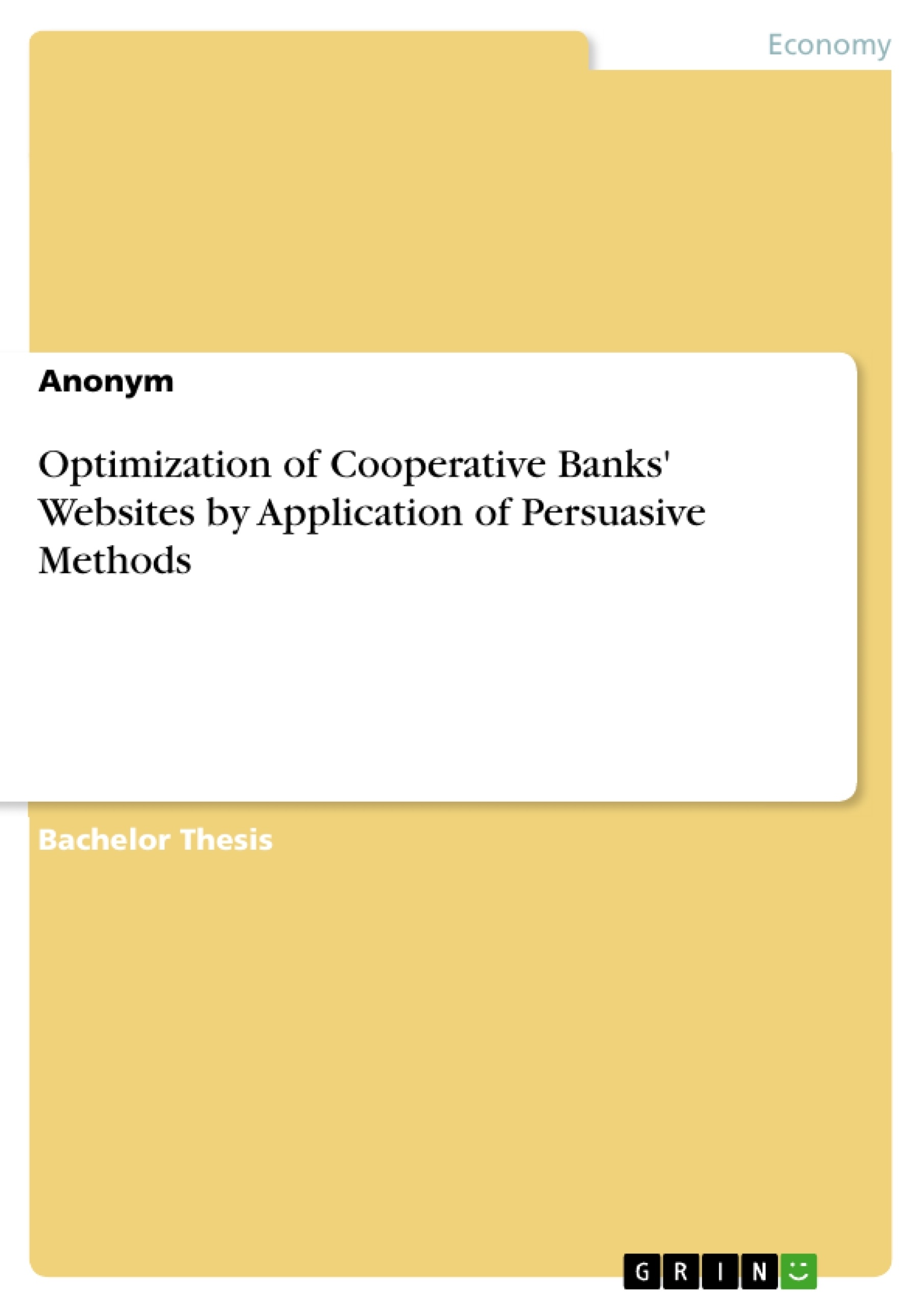The increasing requirements for the effectivity of a website and the more and more complex knowledge about human behavioral patterns are challenging the online presence of banks. Nowadays, a good usability by itself is no significant basis for decision making and the choice of a house bank. Good usability is expected. Rather, the user experience is an essential factor for the success of a website. Due to the fact that the human behavior is determined by unconscious patterns it is necessary to take these into consideration when conceptualizing a website in order to develop a user-centered, target-oriented website design.
By means of persuasive design it is possible to directly address these behavioral patterns. Therefore it is reasonable to optimize the user experience by the application of persuasive design methods. This shall provide a motivating experience in consideration of decision making tools and motives of the user. In this way it is possible to generate competitive advantage and to gain new customers as well as to boost customer loyalty. Here, the need for emotionalizing plays a particularly important role.
But especially in view of banking products it is difficult to create an emotional presentation due to the absence of haptics and because accounts are rather a functional instrument and a means to an end than a product with a high pleasure value. Cooperative banks however benefit particularly from this competitive advantage. Due to the cooperative idea, and their values and principles, they are enabled to address (potential) customers emotionally. If values are illustrated, the users have the opportunity to identify themselves with those, and to align them with their own ideals.
Inhaltsverzeichnis (Table of Contents)
- Introduction
- Starting Position
- Objective and Structure
- Cognitions of Neuromarketing
- Consciousness and Subconsciousness
- Pilot and Autopilot
- Framing Effect
- Priming Effect
- Emotions and Motives of Decisions and Buying Behavior
- Interaction of Emotion and Motive Systems: The Limbic® Map
- Neurobiological Target Group Segmentation: The LimbicⓇ Types
- Codes
- Language
- Storytelling
- Symbols
- Sensors
- Instruments of Persuasive Webdesign
- Persuasion and Mindset
- Rhetoric
- Ethos
- Pathos
- Logos
- Elaboration Likelihood Model
- Heuristic Systematic Model
- Decision Making Process
- Process Phases of the Buying Decision
- Influencing Factors of the Buying Decision
- Fogg's Behavior Model
- Extrinsic Motivation and Flow
- Persuasion by Triggers
- Similarity
- Selection
- Authority
- Scarcity
- Consistent Behavior
- Reciprocity
- Social Proof
- Applicability Analysis for Cooperative Banks
- Cooperative Principles and Values
- Website Objectives
- Online Design Guidelines for Volksbanken Raiffeisenbanken
- Application of Persuasive Webdesign Instruments
- Critical Assessment
- Conclusion
- Target Achievement
- Prospects
Zielsetzung und Themenschwerpunkte (Objectives and Key Themes)
This thesis aims to explore the optimization of cooperative banks' websites by applying persuasive design methods. It investigates how these methods can be used to improve user experience and generate competitive advantage in the banking sector. The study focuses on the specific example of Volksbanken Raiffeisenbanken, analyzing how persuasive design can be used to communicate their cooperative values and principles effectively online.
- The application of persuasive design principles in web design
- The role of neuromarketing and its impact on user behavior
- The importance of emotionalization and building trust in online banking
- The specific challenges and opportunities of applying persuasive design methods in the cooperative banking sector
- The potential for persuasive design to enhance customer engagement and loyalty
Zusammenfassung der Kapitel (Chapter Summaries)
The introduction provides a starting point for the study, outlining the increasing demands for effective website design and the importance of understanding user behavior patterns. It highlights the need for a user-centered approach that goes beyond simple usability and focuses on creating a motivating and engaging experience for users. The chapter also emphasizes the role of emotionalization in banking, particularly for cooperative banks, and introduces the specific example of Volksbanken Raiffeisenbanken.
Chapter 2 delves into the key concepts of neuromarketing, exploring the interplay of consciousness and subconsciousness, the influence of emotions and motives on decision-making, and the use of various codes to communicate effectively with users. It introduces the Limbic® Map as a tool for understanding emotional responses and identifies the LimbicⓇ Types as a framework for neurobiological target group segmentation.
Chapter 3 focuses on the instruments of persuasive web design, examining different approaches to persuasion, including rhetoric, the Elaboration Likelihood Model, and the Heuristic Systematic Model. It analyzes the decision-making process, highlighting the phases of the buying decision and the factors that influence it. The chapter then introduces Fogg's Behavior Model, a framework for understanding and influencing user behavior, and discusses the role of extrinsic motivation and flow in creating engaging experiences. It concludes by exploring persuasion by triggers, examining various techniques such as similarity, selection, authority, scarcity, consistent behavior, reciprocity, and social proof.
Chapter 4 applies the insights from previous chapters to the specific context of cooperative banks. It explores the cooperative principles and values, analyzes the objectives of cooperative banks' websites, and examines the online design guidelines for Volksbanken Raiffeisenbanken. It then delves into the application of persuasive web design instruments in this specific context, providing practical examples and insights. The chapter concludes with a critical assessment of the potential benefits and challenges of implementing persuasive design methods for cooperative banks.
Schlüsselwörter (Keywords)
Persuasive design, neuromarketing, user experience, cooperative banks, online banking, emotionalization, trust, website optimization, customer engagement, customer loyalty, Volksbanken Raiffeisenbanken, Limbic® Map, LimbicⓇ Types, Fogg's Behavior Model, triggers, rhetoric, decision-making process, online design guidelines.
- Quote paper
- Anonym (Author), 2015, Optimization of Cooperative Banks' Websites by Application of Persuasive Methods, Munich, GRIN Verlag, https://www.grin.com/document/349772



